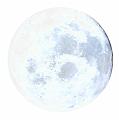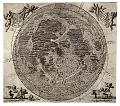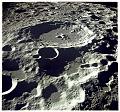THE MOON 15 EARTH' 5 only satellite, about 239,000 miles (384,000 km) away. Next to the Sun it is the brightest object in our sky,more than 2,000 times as bright asVenus. Even without a telescope, we can see large areas on the Moon that are darker than the rest. Early observers imagined these might be seas, and they were given names such as the Sea of Tranquillity. We now know that there is neither liquid water nor an atmosphere on the Moon. The so-called" seas" are plains of volcanic rock where molten lava flowed into huge depressions caused by giant meteorites, then solidified. Volcanic activity on the moon ceased about two billion years ago. Read some facts about the Moon at the bottom, or click here.
Early Moon Map
The same side of the Moon always faces toward Earth. Because the Moon's orbit is not circular and it travels at different speeds, we can see more than half of the Moon. This phenomenon, called libration, means that about 59 percent of the Moon's surface is visible from Earth. In 1647 Johannes Hevelius (1611-1687) published his lunar atlas Selenographia showing the Moon's librations.
Copernicus Crater
The Moon's craters were formed between 3.5 and 4.5 billion years ago by the impact of countless meteorites. These impact craters are all named after famous astronomers and philosophers. Because the Moon has no atmosphere, there has been little erosion of its surface. This plaster model shows Copernicus crater, which is 56 miles (90 km) across and 11,000 ft (3,352 m) deep. Inside the crater there are mountains with peaks 8 miles (5 km) above the crater's floor.
A Lunar Eclipse
An eclipse happens when Earth passes directly between the Sun and the full Moon, so that Earth's shadow falls on the surface of the Moon. This obscures the Moon for the duration of the eclipse.
Tide Tables
The pull of the Moon's gravity, and to a lesser extent, the Sun's, causes the water of the seas on Earth to rise and fall.This effect is called a tide. When the Sun, the Moon, and Earth are all aligned at a new or full moon, the tidal "pull"is the greatest. These are called spring tides. When the Sun and the Moon are at right angles to each other, they produce smaller pulls called neap tides. This compendium (1569) contains plates with tables indicating the tides of some European cities. It was an essential instrument for sailors entering harbor.
Phases of the Moon
The phases of the Moon are caused by the constantly changing series of angles formed by the Sun and the Moon as the Moon revolves around Earth. When the Moon and the Sun are on opposite sides of Earth, the Sun shines directly on the Moon's surface, resulting in a full moon. When the area of the lit surface increases, the Moon is said to be waxing; as it decreases, it is said to be waning.
Surface of the Moon
The features on the far side of the Moon were a mystery until the late 1950s. This view of the terrain was taken by the Apollo 11 lunar module in 1969. One of the primary purposes for exploring the Moon was to bring back samples of rock to study them and to discover their origins. The Moon is made up of similar but not identical material to that found on Earth. There is less iron on the Moon, but the major minerals are silicates as they are on Earth (p.43)-though they are slightly different in composition. This discovery supports the most popular theory of the Moon's origin.A small planet, about the size of Mars, is thought to have crashed into Earth about 4.5 billion years ago. The collision tore debris away from both bodies and the Moon formed from this material.
A Moon Globe
Selenography is the study of the surface features of the Moon. This selenograph, created by the artist John RusseJl in 1797, is a Moon globe. Only a little more than half of the globe is filled with images because at that time the features on the far side of the Moon were unknown. Not until the Russians received the earliest transmissions from the Luna 3 probe in October 1959 was it possible to see images of what was on the Moon's far side.
Facts About the Moon
- Interval between two new moons 29 days 12 hr 44 min
- Temperature at surface -245°F to 220°F (-155°C to 105°C)
- Rotational period 27.3 Earth days
- Mean distance from Earth 239,000 miles/384,000 km
- Volume (Earth = 1) 0.02
- Mass (Earth = 1) 0.012
- Density (water = 1) 3.34
- Equatorial diameter 2,160 miles/3,476 km



